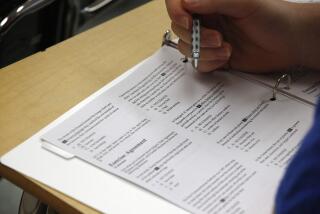User-Friendly Changes in Repackaged SAT : New Name, Format Are the First Alterations in College Admissions Test Since 1974
- Share via
Millions of teen-agers have been hearing about it, waiting for it and even fearing it.
Now it’s here. No, not puberty, Saturday school or a family vacation--it’s the new Scholastic Aptitude Test.
Starting this month, college-bound students will take an SAT whose format has changed for the first time since 1974 (the test has been administered since 1926). That has caused fear in the hearts of some teens, but is panic warranted?
What’s so different about the new SAT?
The name, for one: The A in SAT now stands for Assessment, rather than Aptitude, since there is some valid scholarly debate about whether the test can truly measure a student’s aptitude for learning.
In addition, the SAT that most students will take is called SAT I. The one-hour achievement tests, which some colleges require in addition to the SAT I, are now called the SAT II, and the essay exam that accompanies the SAT II in English composition is now the SAT II writing test. If you can handle the name changes, you are actually over the most frightening part; the changes in format are fairly friendly. The SAT I is still three hours long, and divided into math and verbal sections.
The new math section measures the same kinds of skills as the old: arithmetic, geometry and algebra. The new verbal questions still test students’ skills in reading comprehension, vocabulary, relationships between words and recognition of grammatical parts of sentences.
The time allotted to each section, however, is now broken down differently.
The math section, which consisted of two 30-minute parts, now contains an additional 15-minute section. A 15-minute part also has been added to the usual two 30-minute sections of the verbal portion.
Meanwhile, the SAT I doesn’t include the previous 30-minute section of verbal or math questions that did not count toward the students’ scores.
Regarding the kinds of questions asked on the SAT I, some changes will no doubt please test-takers.
Those who founder on grammar, for example, will be thrilled to know that the SAT I is devoid of the Test of Standard Written English, which included 30 minutes of grammar and punctuation questions.
The reading comprehension section, now named critical reading, contains fewer passages. The passages are generally longer, though, and some must be compared and contrasted.
Some fill-in-the-blank questions will be shorter too; questions requiring you to think of the antonym of a word have been eliminated.
And, contrary to popular rumors, there is no essay portion on the SAT I.
The most talked-about change in the math section is the end of the prohibition on calculators. You must provide your own calculator, though, so check those batteries before you head for the exam.
And although all math questions formerly were multiple choice, there are now some questions for which students must give answers on their own.
Of course, the best way to know what to expect on the SAT I is to practice by taking the PSAT I (Preliminary Scholastic Assessment Test). It is best to take the PSAT in October of your junior year, so you will have enough time to learn your results and strengthen weak points before taking the real test the following spring.
More to Read
Sign up for Essential California
The most important California stories and recommendations in your inbox every morning.
You may occasionally receive promotional content from the Los Angeles Times.













